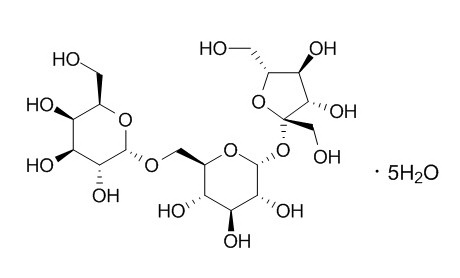Raffinose
After treatment with CVGI, Raffinose family oligosaccharide was hydrolyzed effectively to yield galactose and sucrose. AA-PCD resistance in Raffinose-grown cells occurs with a decrease in both ROS production and cytochrome c release as compared to glucose-grown cells en route to AA-PCD.
Inquire / Order:
manager@chemfaces.com
Technical Inquiries:
service@chemfaces.com
Tel:
+86-27-84237783
Fax:
+86-27-84254680
Address:
1 Building, No. 83, CheCheng Rd., Wuhan Economic and Technological Development Zone, Wuhan, Hubei 430056, PRC
Providing storage is as stated on the product vial and the vial is kept tightly sealed, the product can be stored for up to
24 months(2-8C).
Wherever possible, you should prepare and use solutions on the same day. However, if you need to make up stock solutions in advance, we recommend that you store the solution as aliquots in tightly sealed vials at -20C. Generally, these will be useable for up to two weeks. Before use, and prior to opening the vial we recommend that you allow your product to equilibrate to room temperature for at least 1 hour.
Need more advice on solubility, usage and handling? Please email to: service@chemfaces.com
The packaging of the product may have turned upside down during transportation, resulting in the natural compounds adhering to the neck or cap of the vial. take the vial out of its packaging and gently shake to let the compounds fall to the bottom of the vial. for liquid products, centrifuge at 200-500 RPM to gather the liquid at the bottom of the vial. try to avoid loss or contamination during handling.
J Korean Med Obes Res.2023, 23:10-7
J Chromatogr A.2024, 1714:464544.
The Journal of Supercritical Fluids2021, 176:105305.
Phytomedicine Plus2022, 2(1):100207.
Evid Based Complement Alternat Med.2021, 2021:8707280.
Fitoterapia.2022, 157:105130.
Biomolecules.2021, 11(10):1537.
Chem Biol Interact.2024, 403:111249.
Pharmacol Res.2022, 182:106346.
BioRxiv-The Preprint server for biology2023, 586957.
Related and Featured Products
Biochim Biophys Acta. 2013 Dec;1833(12):2765-74.
Yeast growth in raffinose results in resistance to acetic-acid induced programmed cell death mostly due to the activation of the mitochondrial retrograde pathway.[Pubmed:
23906793 ]
In order to investigate whether and how a modification of mitochondrial metabolism can affect yeast sensitivity to programmed cell death (PCD) induced by acetic acid (AA-PCD), yeast cells were grown on Raffinose, as a sole carbon source, which, differently from glucose, favours mitochondrial respiration.
METHODS AND RESULTS:
We found that, differently from glucose-grown cells, Raffinose-grown cells were mostly resistant to AA-PCD and that this was due to the activation of mitochondrial retrograde (RTG) response, which increased with time, as revealed by the up-regulation of the peroxisomal isoform of citrate synthase and isocitrate dehydrogenase isoform 1, RTG pathway target genes. Accordingly, the deletion of RTG2 and RTG3, a positive regulator and a transcription factor of the RTG pathway, resulted in AA-PCD, as shown by TUNEL assay. Neither deletion in Raffinose-grown cells of HAP4, encoding the positive regulatory subunit of the Hap2,3,4,5 complex nor constitutive activation of the RTG pathway in glucose-grown cells due to deletion of MKS1, a negative regulator of RTG pathway, had effect on yeast AA-PCD. The RTG pathway was found to be activated in yeast cells containing mitochondria, in which membrane potential was measured, capable to consume oxygen in a manner stimulated by the uncoupler CCCP and inhibited by the respiratory chain inhibitor antimycin A.
CONCLUSIONS:
AA-PCD resistance in Raffinose-grown cells occurs with a decrease in both ROS production and cytochrome c release as compared to glucose-grown cells en route to AA-PCD.
J Agric Food Chem. 2013 Aug 14;61(32):7786-93.
Isolation, characterization, and hepatoprotective effects of the raffinose family oligosaccharides from Rehmannia glutinosa Libosch.[Pubmed:
23879777]
This study was aimed to isolate and characterize the Raffinose family oligosaccharides (RGOs) from a novel plant source of Rehmannia glutinosa Libosch, and further evaluate whether RGOs can attenuate CCl4-induced oxidative stress and hepatopathy in mice. HPLC analysis showed that RGOs were mainly composed of stachyose (61.7%, w/w), followed by 23.7% Raffinose and 7.1% sucrose.
METHODS AND RESULTS:
Administration of RGOs orally daily in mice for 21 days significantly reduced the impact of CCl4 toxicity on the serum markers of liver damage, serum alanine aminotransferase (ALT), aspartate aminotransferase (AST), total-cholesterol (TC), and triglycerides (TG). RGOs also increased antioxidant levels of hepatic glutathione (GSH), glutathione peroxidase (GSH-Px), superoxide dismutase (SOD), and total antioxidant capacity (T-AOC), and ameliorated the elevated hepatic formation of malonaldehyde (MDA) induced by CCl4 in mice, which coincided with the histological alteration.
CONCLUSIONS:
These findings exhibited the potential prospect of RGOs as functional ingredients to prevent ROS-related liver damage.
World J Microbiol Biotechnol. 2014 Apr;30(4):1261-7.
Purification an α-galactosidase from Coriolus versicolor with acid-resistant and good degradation ability on raffinose family oligosaccharides.[Pubmed:
24197787]
METHODS AND RESULTS:
An acid-tolerant α-galactosidase (CVGI) was isolated from the fruiting bodies of Coriolus versicolor with a 229-fold of purification and a specific activity of 398.6 units mg⁻1. It was purified to electrophoretic homogeneity by ion exchange chromatography and gel filtration chromatography. The purified enzyme gave a single band corresponding to a molecular mass of 40 kDa in SDS-PAGE and gel filtration. The α-galactosidase was identified by MALDI-TOF-MS and its inner peptides were sequenced by ESI-MS/MS. The optimum temperature and pH of the enzyme were determined as 60 °C and 3.0, respectively. The enzyme was very stable at a temperature range of 4-50 °C and at a pH range of 2-5. Among the metal ions tested, Cu2⁺, Cd2⁺ and Hg2⁺ ions have been shown to partially inhibit the activity of α-galactosidase, while the activity of CVGI was completely inactivated by Ag⁺ ions. N-bromosuccinamide inhibited enzyme activity by 100 %, indicating the importance of tryptophan residue(s) at or near the active site. CVGI had wide substrate specificity (p-nitrophenyl galactoside, melidiose, Raffinose and stachyose). After treatment with CVGI, Raffinose family oligosaccharide was hydrolyzed effectively to yield galactose and sucrose.
CONCLUSIONS:
The results showed that the general properties of the enzyme offer potential for use of this α-galactosidase in several production processes.



